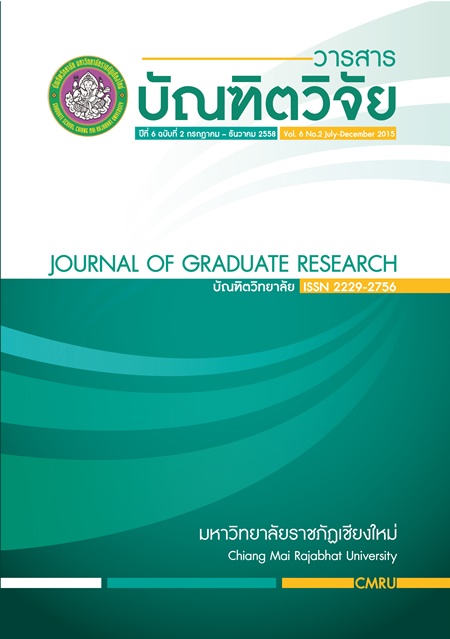กระบวนการสู่ความภักดีในลูกค้าของศูนย์การค้าในจังหวัดชลบุรี
Main Article Content
บทคัดย่อ
การวิจัยนี้ มีจุดมุ่งหมาย เพื่อศึกษาเกี่ยวกับศูนย์การค้าในจังหวัดชลบุรี ซึ่งช่วงปี 2553-ปัจจุบัน กลุ่มบริษัทพัฒนาธุรกิจอสังหาริมทรัพย์ประเภทศูนย์การค้ารายใหญ่ เช่น กลุ่มเซ็นทรัลและเดอะมอลล์ ที่มีการพัฒนาและแผนเปิดดำเนินการศูนย์การค้าในหัวเมืองต่าง ๆ ตามต่างจังหวัด ซึ่งศูนย์การค้าบางแห่งที่เปิดในจังหวัดชลบุรี ต้องใช้เวลาในการปรับตัวกับท้องถิ่นนั้น ๆ ถึง 3 ปี เพื่อให้ได้มาซึ่งจำนวนลูกค้าที่เข้าใช้บริการมากพอ และมีรายรับกับอัตราการเช่าที่อยู่ในสภาวะเสถียรภาพได้ ในขณะที่ศูนย์การค้าของกลุ่มเซ็นทรัลเปิดใหม่ในกรุงเทพใช้เวลาเพียง 6-12 เดือน เนื่องจากพฤติกรรมและความต้องการของลูกค้าในต่างจังหวัดมีความแตกต่างกันกับลูกค้าในกรุงเทพมหานคร ดังนั้นงานวิจัยนี้ จึงมุ่งศึกษาปัจจัยที่ส่งผลให้เกิดความภักดีของลูกค้า (Customer Loyalty) เพื่อให้ศูนย์การค้าที่ขยายกิจการในต่างจังหวัดสามารถทราบถึงปัจจัยสำคัญในพัฒนาการบริหารจัดการทางด้านคุณภาพงานบริการของศูนย์การค้าให้ตรงตามความต้องการและพฤติกรรมของกลุ่มลูกค้าในท้องถิ่นนั้น ๆ ซึ่งจะช่วยให้ผลการดำเนินงานในระยะสั้นและระยะยาวของศูนย์การดีขึ้น การได้มาซึ่งความภักดีของลูกค้าที่มีต่อศูนย์การค้า และท้ายที่สุดจะส่งผลให้ศูนย์การค้าสามารถเพิ่มและรักษาฐานลูกค้าของศูนย์การค้าได้มากขึ้นและสร้างผลประกอบการของศูนย์การค้าในระยะยาวได้อย่างยั่งยืน ผู้วิจัยเก็บข้อมูลจากกลุ่มลูกค้าที่มีประสบการณ์เข้าใช้บริการศูนย์การค้าที่อยู่ในจังหวัดชลบุรี โดยเก็บรวบรวมตั้งแต่วันที่ 15 ธันวาคม 2556 - 18 กุมภาพันธ์ 2557 และได้แบบสอบถามที่ใช้ในการวิเคราะห์ทั้งสิ้น 250 ชุด แล้วจึงนำข้อมูลที่ได้มาวิเคราะห์สมการถดถอย
ผลของการวิจัยนี้แสดงให้เห็นว่าปัจจัยที่ส่งผลต่อความพึงพอใจ (Customer Satisfaction) ได้แก่ คุณภาพงานบริการด้านรูปแบบทางกายภาพ (Physical Aspect) คุณภาพงานบริการด้านปฏิสัมพันธ์ต่อลูกค้า (Personal Interaction) คุณภาพงานบริการด้านนโยบายศูนย์การค้า (Policy) และกิจกรรมเพื่อชุมชน (Local-based Activity) โดยปัจจัยคุณภาพงานบริการด้านรูปแบบทางกายภาพ (Physical Aspect) มีผลมากที่สุด และความพึงพอใจส่งผลต่อไปยัง ความตั้งใจกลับมาใช้บริการ (Revisit Intention) และความตั้งใจกลับมาใช้บริการนั้นมีความสัมพันธ์ต่อความภักดีของลูกค้า (Customer Loyalty) อย่างมีนัยสำคัญ
Article Details
References
วิชารียา เรืองโพธิ์. (2554). ปัจจัยทางการตลาดที่มีอิทธิพลต่อการตัดสินใจเลือกใช้บริการศูนย์การค้าสยามพารากอน. วิทวัส รุ่งเรืองผล. (2545). กลยุทธ์การโฆษณาเฉพาะพื้นที่ Local Area Advertising Strategies. from Marketeer https://www.marketeer.co.th/inside_detail.php?inside_id=1363
สำนักงานสถิติแห่งชาติ. (2554). สถิติรายได้เฉลี่ยต่อครัวเรือนต่อเดือนของหัวเมืองต่างจังหวัด. Retrived from https://service.nso.go.th/nso/web/statseries/statseries11.html
ACNielsen (Producer). (2013, 30 Octorber). เทรนด์ค้าปลีกที่กำลังเปลี่ยนไป. Retrieved from https://www.thanonline.com/index.php?option=com_content&view=article&id=191653:2013-07-19-04-22-48&catid=106:-marketing&Itemid=456
Ahmad, A. E. M. K. (2012). Attractiveness Factors Influencing Shoppers’ Satisfaction, Loyalty, and Word of Mouth: An Empirical Investigation of Saudi Arabia Shopping Malls. International Journal of Business Administration, 3(6).
Bitner, M. J. (1990). Evaluating Service Encounters: The Effects of Physical Surroundings and Employee Responses. Journal of Marketing, 54(2), 69-82. doi: 10.2307/1251871
Bolton, R. N., & Drew, J. H. (1991). A longitudinal analysis of the impact of service changes on customer attitudes. The Journal of Marketing, 1-9.
Bowen, J. T., & Shoemaker, S. (1998). Loyalty: A strategic commitment. Cornell Hotel and Restaurant Administration Quarterly, 39(1), 12-25.
Chen McCain, S.-L., Jang, S., & Hu, C. (2005). Service quality gap analysis toward customer loyalty: practical guidelines for casino hotels. International Journal of Hospitality Management, 24(3), 465-472. doi: https://dx.doi.org/10.1016/j.ijhm.2004.09.005
Chow, K. Y., Dickson Ong, C. S., Tham, W. L., & Wong, Y. K. (2013). Factors influencing dining experience on customer satisfaction and revisit intention among undergraduates towards fast food restaurants. UTAR.
Cronin, J. J., Jr., & Taylor, S. A. (1992). Measuring Service Quality: A Reexamination and Extension. Journal of Marketing, 56(3), 55-68. doi: 10.2307/1252296
Dabholkar, P. A., Thorpe, D. I., & Rentz, J. O. (1995). A Measure of Service Quality for Retail Stores: Scale Development and Validation. Journal of the Academy of Marketing Science, 24(1), 3-16. doi: 10.1177/009207039602400101
Dongjin, L. I., Shenghui, A. N., & Kai, Y. (2008). Exploring Chinese consumer repurchasing intention for services: An empirical investigation. Journal of Consumer Behaviour, 7(6), 448-460. doi: 10.1002/cb.263
Hart, C., Farrell, A. M., Stachow, G., Reed, G., & Cadogan, J. W. (2007). Enjoyment of the Shopping Experience: Impact on Customers’ Repatronage Intentions and Gender Influence. The Service Industries Journal, 27(5), 583-604. doi: 10.1080/02642060701411757
Jay, K., & Dwi, S. (2000). Customer loyalty in the hotel industry: the role of customer satisfaction and image. [DOI: 10.1108/09596110010342559]. International Journal of Contemporary Hospitality Management, 12(6), 346-351.
Koo, D.-M. (2003). Inter-relationships among store images, store satisfaction, and store loyalty among Korea discount retail patrons. Asia Pacific Journal of Marketing and Logistics, 15(4), 42-71.
Lim, C. M., Kim, Y.-K., & Park, S.-H. (2007). Consumer perceptions toward retail attributes of value retailers: functions of gender and repatronage intention. Journal of Customer Behaviour, 6(3), 269-282.
Lu, Y., & Seock, Y.-K. (2008). The influence of grey consumers’ service quality perception on satisfaction and store loyalty behavior. International Journal of Retail & Distribution Management, 36(11), 901-918. doi: 10.1108/09590550810911674
Malhotra, N. K. (2008). Marketing research: An applied orientation, 5/e: Pearson Education India.
Markovic, S., & Raspor, S. (2010). Customer Satisfaction and Customer Loyalty Measurement In Hotel Settings: An Empirical Analysis. Tourism and Hospitality Management, 125-137.
Mechinda, P., Serirat, S., & Gulid, N. (2009). An examination of tourists’ attitudinal and behavioral loyalty: comparison between domestic and international tourists. Journal of Vacation Marketing, 15(2), 129-148.
Mehta, S. C., Lalwani, A. K., & Han, S. L. (2000). Service quality in retailing: relative efficiency of alternative measurement scales for different product-service environments. International Journal of Retail & Distribution Management,28(2), 62-72. doi: 10.1108/09590550010315106O
liver, R. (1981). Measurement and Evaluation of Satisfaction Processes in Retail Settings. [Article]. Journal of Retailing, 57(3), 25.
Oliver, R. (1997). Satisfaction: A behavioral perspective on the consumer. New York ' NY: Irwin-McGraw-Hill.
Oliver, R. (1999). Whence consumer loyalty? The Journal of Marketing, 33-44.
Parasuraman, A., Zeithaml, V. A., & Berry, L. L. (1988). SERVQUAL: A Multiple-Item Scale for Measuring Consumer Perceptions of Service Quality. [Article]. Journal of Retailing, 64(1), 12-40.
Parker, C., & Mathews, B. P. (2001). Customer satisfaction: contrasting academic and consumers’ interpretations. Marketing Intelligence & Planning, 19(1), 38-44. doi: 10.1108/02634500110363790
Reichheld, F. F., & Sasser, W. E. (1990). Zero defections: quality comes to services. Harvard business review,68(5), 105-111.
Riadh, L. (2012). The lodging quality index: an independent assessment of validity and dimensions. [DOI: 10.1108/09596111211217914]. International Journal of Contemporary Hospitality Management, 24(4), 628-652.
Santouridis, I., & Trivellas, P. (2010). Investigating the impact of service quality and customer satisfaction on customer loyalty in mobile telephony in Greece. The TQM Journal, 22(3), 330-343.
Siu, N. Y. M., & Chow, D. K. H. (2003). Service Quality in Grocery Retailing. Journal of International Consumer Marketing, 16(1), 71-87. doi: 10.1300/J046v16n01_05
Som, A. P. M., Marzuki, A., Yousefi, M., & AbuKhalifeh, A. N. (2012). Factors influencing visitors’ revisit behavioral Intentions: A case study of Sabah, Malaysia. International Journal of Marketing Studies,4(4), p39.
Teller, C., & Elms, J. (2010). Managing the attractiveness of evolved and created retail agglomerations formats. Marketing Intelligence & Planning, 28(1), 25-45. doi: 10.1108/02634501011014598
Tsai, S.-p. (2009). Shopping mall management and entertainment experience:a cross-regional investigation. The Service Industries Journal, 30(3), 321-337. doi: 10.1080/02642060802123376
Wakefield, K. L., & Baker, J. (1998). Excitement at the mall: Determinants and effects on shopping response. Journal of Retailing, 74(4), 515-539. doi: https://dx.doi.org/10.1016/S0022-4359(99)80106-7

